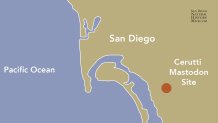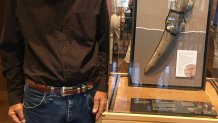Fossils uncovered in San Diego 25 years ago show that humans inhabited North America at least 115,000 years earlier than previously thought, according to researchers.
The San Diego Natural History Museum announced the findings to the public on Wednesday.
“It’s the 130,000 year age of this site that’s the really extraordinary result of our research,” said SDNHM paleontology curator Tom Deméré.
The prehistoric bones were uncovered in November 1992 along the construction site of State Route 54.
Field paleontologist Richard Cerutti carefully worked to extricate the bones of what would soon be known to be a mastodon.
However, the position of other stones and bones in the area created what was described as a “paleo crime scene.”

Scientists soon realized it was an archaeological site, not a paleontological one, that contained preserved evidence of human activity.
U.S. & World
“As scientists we follow the evidence no matter where it leads,” said Deméré. “Who would think in this sort of setting we’d make such a startling discovery.”
Sites with evidence of humans in North America are typically around 14,000 years old. Some researchers now believe the San Diego site marks a much older beginning of humans in North America, though that is not definitive.
The site included clusters of rocks believed to have been used as tools. Richard Fullagar of the University of Wollongong, Australia, confirmed stones found at the San Diego site showed the same wear marks as stones used as tools in other sites.
But some are skeptical that the rocks were really used as tools. Vance Holliday of the University of Arizona in Tucson told The Associated Press the paper shows the bones could have been broken the way the authors assert, but they haven't demonstrated that's the only way.

Steve Holen, former curator of archaeology at the Denver Museum of Nature & Science, traveled to San Diego in 2008. His experiments about stone tools were used to determine some of the bone fragments were broken apart in that way.
Holen called the discovery the biggest shock of his scientific career.
“Once I realized in my mind how old this site was, I could not believe that humans were here at that time,” Holen said. “It went against everything I’d ever been taught and everything that I ever thought I knew. It was quite shocking.”
He said they believe the location was a place where humans took bones and made tools.
In 2011, technological advances enabled Jim Paces of the U.S. Geological Survey to use state-of-the-art radiometric dating methods to date the mastodon bones to 130,000 years old.
“It’s been a long, hard process,” he said. Their results, he said, are based on hundreds of analyses.
“We anticipate people will be curious to see if they can’t replicate those results,” Paces said.
NBC 7 Archive Images of 1992 Site Mastodon Discovery
Museum officials said there is no doubt the announcement raises more questions than answers.
Not all researchers are convinced about the conclusion that humans arrived earlier than previously known.
"I was astonished not because it is so good and important, but because it is so bad," Donald Grayson, an archaeologist at the University of Washington, wrote in a statement.
Grayson added he feels the "real mystery" is how the report was published in the scientific journal "Nature."
"It is one thing to show that broken bones and modified rocks could have been produced by people, which Holen and his colleagues have done," Grayson wrote. "It is quite another to show that people, and people alone, could have produced those modifications."
Richard Potts of the Smithsonian Institution's National Museum of Natural History, told The Associated Press he doesn't reject the paper's claims outright, but he finds the evidence "not yet solid."
There are plans to begin field surveys looking for other sites of a similar age in geological deposits across Southern California, Holen said. Researchers will also look at museum collections to use similar analysis on those fossils.



